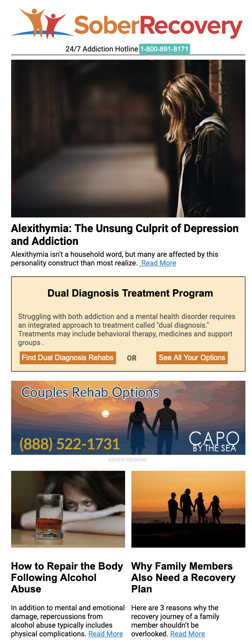Summary of Nicotine Addiction Howell MI
Substance abuse
Types of Care
Outpatient
Special Programs/Groups
Adolescents, Women, Men, DUI/DWI offenders, Criminal justice clients

Substance abuse
Types of Care
Outpatient

Brighton, MI
Substance abuse
Types of Care
Outpatient
Special Programs/Groups
Criminal justice clients

Substance abuse
Types of Care
Outpatient
Language Services
Arabic, Chaldean

Substance abuse , Detoxification, Buprenorphine Services
Types of Care
Outpatient
Special Programs/Groups
Adolescents, Pregnant/postpartum women, DUI/DWI offenders

Substance abuse
Types of Care
Outpatient
Special Programs/Groups
Adolescents, Persons with co-occurring mental and substance abuse disorders, Women, DUI/DWI offenders, Criminal justice clients
Language Services
ASL or other assistance for hearing impaired

Substance abuse , Detoxification
Types of Care
Outpatient
Special Programs/Groups
Adolescents, Persons with co-occurring mental and substance abuse disorders, Persons with HIV/AIDS, Gays and Lesbians, Seniors/older adults, Women, Men

Substance abuse , Detoxification, Halfway house, Buprenorphine Services
Types of Care
Hospital inpatient, Residential short-term treatment (30 days or less), Residential long-term treatment (more than 30 days), Outpatient
Special Programs/Groups
Women, Men, DUI/DWI offenders
Language Services
ASL or other assistance for hearing impaired

Substance abuse
Types of Care
Outpatient

Substance abuse , Buprenorphine Services
Types of Care
Residential short-term treatment (30 days or less), Residential long-term treatment (more than 30 days), Outpatient
Special Programs/Groups
Men, DUI/DWI offenders, Criminal justice clients
Language Services
ASL or other assistance for hearing impaired


Summary of Nicotine Addiction
Nicotine Addiction is a well-known among the teen community. Nicotine dependence can be successfully treated. The drug ‘Nicotine’ is a psychoactive drug with effects that reinforce tobacco use even though known harmful health effects. Family physicians are in an excellent position to promote both smoking cessation and smoking prevention. Nicotine is a psychoactive agent whose continued use usually leads to addiction. The pharmacologic and psychologic processes that determine nicotine addiction are similar to those that determine addiction to other drugs, such as heroin and cocaine. The most common form of nicotine dependence is associated with the inhalation of cigarette smoke. Pipe and cigar smoking, tobacco chewing and the use of snuff are less likely to lead to nicotine dependence. This article, therefore, focuses on cigarette smoking as the primary agent of nicotine addiction.
Cigarette smoking may be responsible for as many as 350,000 deaths annually in the United States, representing 18 percent of all deaths. Total costs of smoking-related health care and lost productivity amount to approximately $65 billion each year.
Despite escalating cigarette consumption worldwide, U.S. smoking rates are declining. Consumption reached a peak in the early 1960s, when 42 percent of adults smoked (52 percent of men and 34 percent of women). Per capita consumption began to drop after 1964, when the U.S. Surgeon General reported tobacco use to be a major health hazard. Currently, 26...
Click here to read the rest of this article from Sober Recovery
Featured Facilities
At Skywood, we are deeply invested in helping you regain your health. Our programming approach to recovery is designed with that in mind, from individual and group therapy to adventure therapy, art therapy and yoga. Each of these activities builds on the others to get to the root causes of addiction, introduce healthy new habits, address any co-occurring mental health issues and provide the mental and physical space you need in order to heal. We also provide access to regular 12-Step meetings and peer support groups. What we do at Skywood is different for several reasons. First, we treat addiction and mental health at the same time in a highly integrated way, looking to restore a person’s physical, emotional, mental and spiritual well-being. Second, we focus on resolving trauma, underlying issues and deep-rooted emotional pain that often causes substance abuse in the first place. Lastly, we emphasize life skills that help each person build a foundation for sustainable, long-term recovery.
Sanctuary at Cherry Hill is a medically proven recovery facility that provides comprehensive treatment for substance use and co-occurring disorders. Sanctuary Health utilizes Everlasting Recovery, an approach that aligns our client’s recovery journey directly with their life, to extend recovery into a client’s lifestyle. Our unique approach establishes treatment as a daily practice, refocuses an individual away from addiction towards a healthier existence, and makes sustainable recovery achievable. Due to this integration, each client begins Everlasting Recovery by assessing their performance in various aspects of their lives via the bio, psycho, and social model. This initial assessment allows our therapists to craft a personal recovery program, which allows the greatest opportunity for our clients to suppress addiction and adopt recovery as a permanent identity. When attending Sanctuary at Cherry Hill, our clients will establish life skills, implement daily routines for lifestyle recovery, and ignite a purpose for achieving better their lives. Through accomplishing these tasks, our clients will achieve sustainable recovery.
Addiction is a disease that no one should have to deal with alone. It is imperative that citizens of a city or county have access to top quality addiction treatment services. People from all walks of life can be susceptible to developing a substance use disorder in response to trauma they have endured, or lifestyle circumstances begetting maladaptive coping mechanisms.When a person is in the grips of addiction, they can become isolated and unable to see their condition for what it is—an illness that can be managed.Whether you are in Nashville or in the greater Nashville area such as Brentwood, Franklin, Hendersonville, etc, at Southeast Addiction, our outpatient addiction treatment programs offer something for individuals of all levels of commitment.
Lake Ariel Recovery Center, like all of the Sanctuary Health Group facilities, is a medically proven recovery facility that provides comprehensive treatment for substance use and co-occurring disorders. Sanctuary Health utilizes Everlasting Recovery, an approach that aligns our client’s recovery journey directly with their life, to extend recovery into a client’s lifestyle. Our unique approach establishes treatment as a daily practice, refocuses an individual away from addiction towards a healthier existence, and makes sustainable recovery achievable. Due to this integration, each client begins Everlasting Recovery by assessing their performance in various aspects of their lives via the bio, psycho, and social model. This initial assessment allows our therapists to craft a personal recovery program, which allows the greatest opportunity for our clients to suppress addiction and adopt recovery as a permanent identity. When attending Lake Ariel Recovery Center, our clients will establish life skills, implement daily routines for lifestyle recovery, and ignite a purpose for achieving better their lives. Through accomplishing these tasks, our clients will achieve sustainable recovery.




